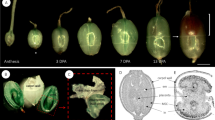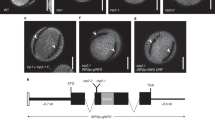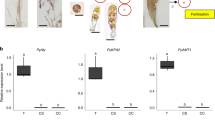Abstract
IN the formation of the exine of the pollen grain, the highly resistant wall polymer, sporopollenin, is laid down in a series of layers. Of these, the outer, the sexine of Erdtman's terminology1, is often strongly sculptured. Sexine pattern may have high taxonomic specificity, and because the sculpturing is executed in so refractory a material, the morphogenetic processes concerned are of considerable interest. Rowley and Southworth2 have shown that in the formation of the inner exine layer near the germinal aperture of the microspore of Anthurium sp., sporopollenin is deposited on lamellae of “unit membrane dimensions”. The superimposition and compaction of these lamellae as the coating of sporopollenin thickens produce the layer corresponding to the nexine 2. Essentially the same process has been described and illustrated by Godwin et al.3 in the growth of this stratum in Ipomoea purpurea. It is clear from various earlier reports4–7 that the inner exine layer may often reveal lamellation even at maturity, indicating this kind of origin. The sexine and nexine 1, formed earlier than the nexine 2, usually reveal no lamellation, and Godwin et al.3 were forced to conclude that these parts of the exine have a different mode of origin. We show in this communication that all strata of the exine of Lilium longiflorum originate through a process involving the association or apposition of lamellae. Because the lamellae are generated near the plasmalemma, the observation re-emphasizes the role of this membrane and the cortical cytoplasm in the determination of exine pattern.
This is a preview of subscription content, access via your institution
Access options
Subscribe to this journal
Receive 51 print issues and online access
$199.00 per year
only $3.90 per issue
Buy this article
- Purchase on Springer Link
- Instant access to full article PDF
Prices may be subject to local taxes which are calculated during checkout
Similar content being viewed by others
References
Erdtman, G., Pollen Spores, 8, 5 (1966).
Rowley, J. R., and Southworth, D., Nature, 213, 703 (1967).
Godwin, H., Echlin, P., and Chapman, B., Rev. Palaeobot. Palynol., 3, 181 (1967).
Afzelius, B., Bot. Not., 108, 141 (1955).
Ehrlich, H. G., Exp. Cell Res., 115, 463 (1958).
Larson, D. A., and Lewis, C. W., Amer. J. Bot., 48, 934 (1961).
Larson, D. A., and Lewis, C. W., Grana Palynol., 3, 21 (1963).
Heslop-Harrison, J., Science, 161, 229 (1968).
Heslop-Harrison, J., Canad. J. Bot., 46, 1185 (1968).
Heslop-Harrison, J., Port. Acta Biol., 10, 235 (1968).
Echlin, P., and Godwin, H., J. Cell Sci., 3, 161 (1968).
Stix, E., Grana Palynol., 5, 289 (1964).
Author information
Authors and Affiliations
Rights and permissions
About this article
Cite this article
DICKINSON, H., HESLOP-HARRISON, J. Common Mode of Deposition for the Sporopollenin of Sexine and Nexine. Nature 220, 926–927 (1968). https://doi.org/10.1038/220926a0
Received:
Revised:
Issue Date:
DOI: https://doi.org/10.1038/220926a0
This article is cited by
-
Phenotypic, genetic, and molecular function of msc-2, a genic male sterile mutant in pepper (Capsicum annuum L.)
Theoretical and Applied Genetics (2020)
-
Acyl-CoA synthetases from Physcomitrella, rice and Arabidopsis: different substrate preferences but common regulation by MS188 in sporopollenin synthesis
Planta (2019)
-
Identification of candidate genes underlying genic male-sterile msc-1 locus via genome resequencing in Capsicum annuum L.
Theoretical and Applied Genetics (2018)
-
OsACOS12, an orthologue of Arabidopsis acyl-CoA synthetase5, plays an important role in pollen exine formation and anther development in rice
BMC Plant Biology (2016)
-
The tapetal AHL family protein TEK determines nexine formation in the pollen wall
Nature Communications (2014)
Comments
By submitting a comment you agree to abide by our Terms and Community Guidelines. If you find something abusive or that does not comply with our terms or guidelines please flag it as inappropriate.



